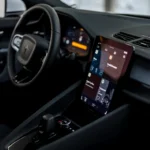How EVs are transforming the automobile industry and why you should buy one

Electric vehicles (EVs) are vehicles that run on electricity instead of fossil fuels. They have several advantages over conventional internal combustion engine (ICE) vehicles, such as lower emissions, lower operating costs, and higher efficiency. EVs are also seen as a key solution to tackle climate change and reduce air pollution in cities.
In this report, we will explore why EVs are the future of the automobile industry, how they are transforming the mobility landscape, and what challenges and opportunities they present for various stakeholders.
The rise of EVs

The global EV market has been growing rapidly in recent years, driven by several factors such as:
- Regulation. Governments and cities have introduced regulations and incentives to accelerate the shift to sustainable mobility. Regulators worldwide are defining more stringent emissions targets. The European Union presented its “Fit for 55” program, which seeks to align climate, energy, land use, transport, and taxation policies to reduce net greenhouse gas emissions by at least 55% by 2030, and the Biden administration introduced a 50 percent EV target for 2030. Beyond such mandates, most governments are also offering EV subsidies. Cities are working to reduce private vehicle use and congestion by offering greater support for alternative mobility modes like bicycles. Many urban areas are also implementing access regulations for cars. In fact, over 150 cities in Europe have already created access regulations for low emissions and pollution emergencies.
- Consumer behavior. Consumer behavior and awareness are changing as more people accept alternative and sustainable mobility modes. Inner city trips with shared bicycles and e-scooters have risen 60 percent year-over-year and the latest McKinsey consumer survey suggests average bicycle use (shared and private) may increase more than 10 percent in the post-pandemic world compared with pre-pandemic levels. In addition, consumers are becoming more open to shared-mobility options. More than 20 percent of Germans surveyed say they already use ride-pooling services (6 percent do so at least once per week), which can help reduce vehicle miles traveled and emissions.
- Technology. Industry players are accelerating the speed of automotive technology innovation as they develop new concepts of electric, connected, autonomous, and shared mobility. The shift from ICE to EV has increased the electronics content from 16% to 55% in a vehicle with the addition of new features and controls. Many of these technologies are going to become standard offerings in the future and the addition of newer features/ development of new technology is going to be a continual process. The cost and performance of batteries, which are the key component of EVs, have also improved significantly over time. According to J.P. Morgan, battery costs have declined by 80% since 2010 and are expected to fall further as production scales up and new chemistries emerge. Moreover, EVs can benefit from the integration of renewable energy sources, smart grids, and vehicle-to-grid (V2G) technologies that can enhance their environmental and economic value.
The impact of EVs

The adoption of EVs will have profound implications for various aspects of the mobility ecosystem, such as:
- Vehicle manufacturers. EVs represent a major opportunity for vehicle manufacturers to gain a competitive edge in the market and meet the changing customer preferences and regulatory requirements. However, they also pose significant challenges in terms of product development, manufacturing, supply chain management, distribution, and after-sales service. Vehicle manufacturers will need to invest heavily in R&D, innovation, partnerships, and talent to succeed in the EV space. They will also need to adapt their business models and strategies to cope with lower margins, higher complexity, and new competitors.
- Suppliers. EVs will create new demand for components such as batteries, electric motors, power electronics, sensors, software, and charging equipment. Suppliers that can provide these products with high quality, reliability, and affordability will benefit from the EV boom. However, they will also face increased competition from new entrants, especially from China and other emerging markets. Suppliers will need to diversify their product portfolio, optimize their cost structure, enhance their capabilities, and collaborate with vehicle manufacturers and other stakeholders to capture the EV opportunity.
- Dealers. EVs will change the role and function of dealers in the mobility value chain. Dealers will need to offer new services such as charging installation,
maintenance, education, and consulting to attract and retain EV customers. Dealers will also face lower demand for repair and maintenance services, as EVs have fewer moving parts and lower wear and tear than ICE vehicles. Dealers will need to rethink their value proposition, revenue streams, and cost structure to survive and thrive in the EV era. - Charging infrastructure providers. EVs will require a widespread and reliable network of charging stations to enable convenient and fast recharging for drivers. Charging infrastructure providers will need to invest in building and operating charging networks that can meet the diverse needs of EV users across different locations and use cases. They will also need to overcome technical, regulatory, and financial barriers to ensure interoperability, standardization, safety, and profitability of their charging services. Charging infrastructure providers will need to collaborate with vehicle manufacturers, utilities, regulators, and other stakeholders to create a seamless and integrated charging ecosystem.
- Utilities and grid operators. EVs will increase the demand for electricity and pose new challenges and opportunities for utilities and grid operators. On one hand, EVs can create additional revenue sources for utilities by providing a large and flexible load that can be managed through smart charging and V2G technologies. On the other hand, EVs can also create grid congestion and instability if they are not coordinated with the supply and demand of electricity. Utilities and grid operators will need to upgrade their infrastructure, adopt digital solutions, and implement innovative pricing and incentive schemes to accommodate the growing EV load and leverage its potential benefits.
The outlook of EVs

The future of EVs is bright and promising, as they offer a cleaner, cheaper, and smarter way of mobility. According to J.P. Morgan, EVs and hybrid electric vehicles (HEVs) will account for an estimated 30% of all vehicle sales by 2025. McKinsey projects that by 2030, EVs could represent up to 50% of new car sales in China, 35% in Europe, and 25% in the United States. The adoption of EVs will also vary by segment, with passenger cars leading the way, followed by light commercial vehicles, buses, trucks, and two-wheelers.
However, the future of EVs is not without uncertainties and risks. The pace and scale of EV adoption will depend on several factors such as consumer preferences, technology development, policy support, infrastructure availability, competitive dynamics, and environmental awareness. The COVID-19 pandemic has also introduced new challenges and opportunities for the EV industry, as it has disrupted the supply chains, reduced the demand for mobility, accelerated the digitalization trends, and heightened the social consciousness.
Therefore, it is essential for all stakeholders involved in the EV value chain to monitor the market trends, anticipate the customer needs, innovate the product offerings,
and collaborate with each other to shape the future of EVs.
FAQs
What are the benefits of EVs?
EVs have several benefits over ICE vehicles, such as:
- Lower emissions. EVs produce zero tailpipe emissions and can reduce greenhouse gas emissions by up to 70% compared to ICE vehicles, depending on the electricity source.
- Lower operating costs. EVs have lower fuel and maintenance costs than ICE vehicles, as electricity is cheaper than gasoline and EVs have fewer moving parts and fluids that need to be replaced.
- Higher efficiency. EVs convert about 80% of the electrical energy to power the wheels, while ICE vehicles only convert about 20% of the energy stored in gasoline.
- Higher performance. EVs have instant torque, smooth acceleration, and quiet operation, which enhance the driving experience and comfort.
- Higher connectivity. EVs can communicate with the grid, other vehicles, and smart devices, which enable features such as smart charging, V2G, remote control, and over-the-air updates.
What are the challenges of EVs?
EVs also face some challenges that need to be addressed, such as:
- Lack of charging infrastructure. EVs require a widespread and reliable network of charging stations to enable convenient and fast recharging for drivers. However, the current charging infrastructure is insufficient and unevenly distributed across regions and locations.
- High upfront costs. EVs have higher purchase prices than ICE vehicles, mainly due to the high cost of batteries. Although the battery costs have declined significantly over time, they still account for about 30% to 40% of the total EV cost.
- Range anxiety. EVs have limited driving range compared to ICE vehicles, which can cause anxiety and inconvenience for drivers who need to travel long distances or in areas with scarce charging options.
- Consumer awareness. EVs are still relatively new and unfamiliar to many consumers, who may have misconceptions or doubts about their performance, safety, reliability, and usability.
- Policy uncertainty. EVs are subject to various policies and regulations that can affect their adoption and competitiveness. These include emissions standards, fuel taxes, subsidies, incentives, access restrictions, and vehicle-to-grid rules.
What are the types of EVs?
There are different types of EVs based on the degree of electrification and the power source, such as:
- Battery electric vehicles (BEVs). BEVs run solely on electricity stored in batteries and have no ICE or fuel tank. They need to be plugged in to recharge their batteries.
- Plug-in hybrid electric vehicles (PHEVs). PHEVs have both an electric motor and an ICE that can work together or separately. They can run on electricity stored in batteries or gasoline stored in a fuel tank. They need to be plugged in to recharge their batteries.
- Hybrid electric vehicles (HEVs). HEVs have both an electric motor and an ICE that work together to optimize the fuel efficiency and performance. They cannot run on electricity alone and do not need to be plugged in. They recharge their batteries through regenerative braking or the ICE.
- Fuel cell electric vehicles (FCEVs). FCEVs run on electricity generated by a fuel cell that uses hydrogen as a fuel. They have no ICE or batteries. They need to be refueled with hydrogen at a hydrogen station.
How long does it take to charge an EV?
The charging time of an EV depends on several factors such as:
- The battery capacity. The larger the battery capacity, the longer it takes to charge.
- The state of charge. The lower the state of charge, the faster it charges at first, but then it slows down as it approaches full charge.
- The charging power. The higher the charging power, the faster it charges. The charging power depends on the type of charger and the vehicle’s onboard charger.
- The ambient temperature. The colder the temperature, the slower it charges.
The charging time can vary from a few minutes to several hours depending on these factors. For example, a typical BEV with a 60 kWh battery capacity can take about 8 hours to charge from empty to full using a level 2 charger (240 volts) at home or at work, or about 30 minutes to charge from 20% to 80% using a fast charger (50 kW) in public or on highways.
Conclusion

EVs are the future of the automobile industry, as they offer a sustainable solution to the mobility challenges of today and tomorrow. EVs have multiple advantages over ICE vehicles in terms of emissions, costs, efficiency, performance, and connectivity. However, EVs also face several barriers such as lack of charging infrastructure, high upfront costs, range anxiety, consumer awareness, and policy uncertainty.
To overcome these barriers and realize the full potential of EVs, all stakeholders in the mobility ecosystem need to work together to create a conducive environment for EV adoption. This includes vehicle manufacturers, suppliers, dealers, charging infrastructure providers, utilities, grid operators, regulators, policymakers, and consumers. By doing so, they can not only benefit from the economic opportunities and competitive advantages that EVs offer, but also contribute to the social welfare and environmental protection that EVs enable.
This Report is made by: US Trending
*Source: IEA, J.P.Morgan, ET, McKinsey …etc.






